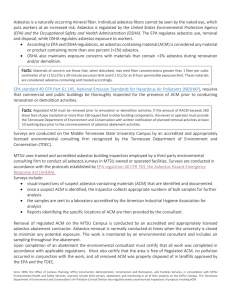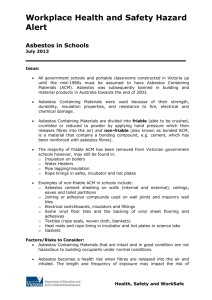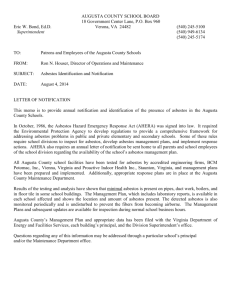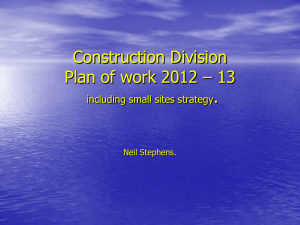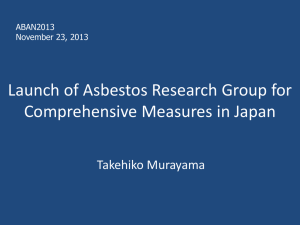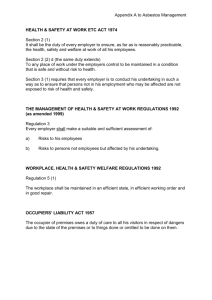Asbestos Awareness
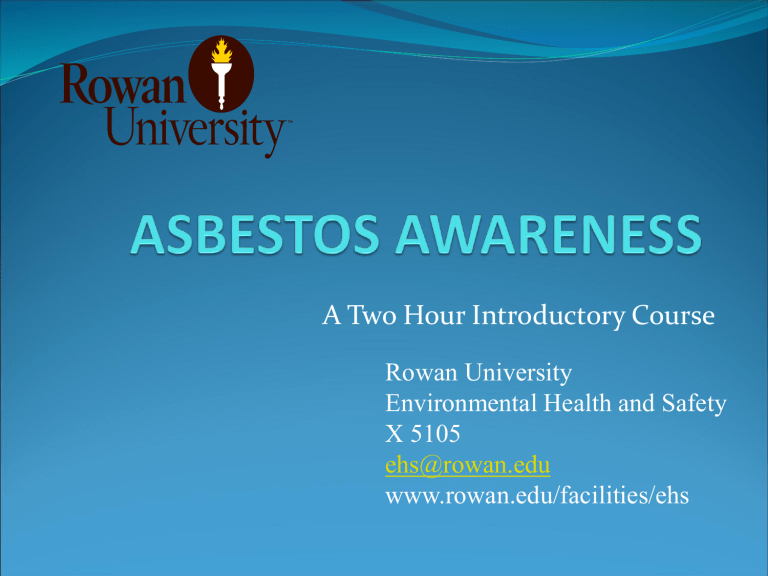
A Two Hour Introductory Course
Rowan University
Environmental Health and Safety
X 5105 ehs@rowan.edu
www.rowan.edu/facilities/ehs
COURSE OVERVIEW
Introduction
Identification of Asbestos
History and Uses of Asbestos
Routes of Entry
Health Effects of Asbestos Exposure
Exposure Monitoring
COURSE OVERVIEW
Protection From Asbestos Exposure
Assessment of ACM Damage
Location of ACM
Summary/Questions and Answers
Adjourn
WHAT IS ASBESTOS?
Naturally Occurring “A Rock”
Silicate Mineral
Chemical Resistant
Longitudinal Cleavage
Shape
Serpentine
Chrysotile
Amphibole
Amosite, and Crocidolite
>3,000 Building Products
Desirable Physical Properties
ACM >1% Asbestos
HISTORY OF ASBESTOS USE
Greek Blankets
Egyptian Bricks
Fire Protection
WHERE CAN YOU FIND ASBESTOS?
EVERYWHERE
• Insulation
• Friction Products
• Construction Materials
• Resilient Coatings
• Fireproofing
• Clothing
SPRAY-ON FIREPROOFING
SPRAY-ON FIREPROOFING
FLOOR TILE
PIPE INSULATION
Boiler Wrapping and Cement
Pipes
FRIABLE VS. NONFRIABLE
Friable – asbestos capable of being released into the air by hand pressure.
Non-Friable – must use mechanical means to become friable.
ROUTES OF ENTRY
Inhalation
Ingestion
But NOT
• Absorption
• Injection
RESPIRATORY SYSTEM ANATOMY
HEALTH EFFECTS
Asbestosis
Lung Cancer
Mesothelioma
Other Cancers
Pleural Plaques/Asbestos Warts
Inhalation Hazard
Must Be Disturbed
Latency Period (15 to 40 years)
EXPOSURE MONITORING
Air Sampling
Area Samples
Personal Samples
PROTECTION FROM EXPOSURE-PPE
Disposable Suits
Disposable Footwear
Disposable Gloves
If Using Chemicals - Add for Specific Chemical
PROTECTION FROM EXPOSURE-RESP.
Best Protection From Exposure
You Need to Wear the Right Mask With the Right
Accessories
YOU MAY NOT WEAR A RESPIRATOR AT YOUR JOB
UNLESS YOU HAVE BEEN TRAINED AND CLEARED
FOR USE
CARTRIDGES
Mechanical Filters
N,R,P
95, 99, 100
Chemical Filters
Absorbent
Adsorbent
MASKS
Dust Masks
1/2 Face Masks
Negative Pressure
Positive Pressure
Full Face Masks
Negative Pressure
Positive Pressure
PERSONAL PROTECTION - HYGIENE
The Best Protection Is Common Sense
Wash Your Hands and Face Frequently
No Eating, Drinking, or Smoking During Asbestos
Work
If You Get Dirty, Change and Wash Your Clothes
Separately
ASSESSMENT OF ACM DAMAGE
Physical Damage
Cuts, Breakage, Alteration, Friction
Water Damage
Delamination
Deterioration
RECOGNITION OF DAMAGE
LOCATION OF ACM
Review the Comprehensive Building Survey
Observe the Warning Labels
EMERGENCY PROCEDURES
Major Fiber Release (> 3 sq.ft)
Stop Work Immediately
Do Not Attempt Clean-up
Secure Area
Notify Supervisor
Contact Emergency Personnel
Do Not Reenter Area Until Instructed To
Do So
RULES AND REGULATIONS
OSHA
EPA
New Jersey Subchapter 8
ACBM MANAGEMENT
Abatement
O&M
ABATEMENT ACTIVITIES
Encapsulation
Enclosure
Removal
ABATEMENT ACTIVITIES
Survey to Identify ACM
Project Designer
Occupant Notification
Work Area Containment
Posting of Work Areas
Engineering Controls/PPE
Air Monitoring
Accredited Contractor
O&M ACTIVITIES
In-House Small Scale, Short Duration
Projects
Maintenance or Repair Only
160 Square Feet/260 Linear Feet/35
Cubic Feet
Trained Personnel
Schedule and Coordinate with EH&S prior to activity (including floor tile and other non-friable material)
Quiz
What is Asbestos?
Name 3 Building Materials That May
Contain Asbestos?
Name 3 Diseases Associated With
Asbestos Exposure?
When is Asbestos a Health Hazard?
What Greatly Increases the Risk of
Lung Cancer?
What Should You Do If You Identify
Damaged ACM?
ANY QUESTIONS??





